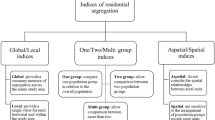Abstract
We propose a new spatial scan statistic based on graph theory as a method for detecting irregularly-shaped clusters of events over space. A graph-based method is proposed for identifying potential clusters in spatial point processes. It relies on linking the events closest than a given distance and thus defining a graph associated to the point process. The set of possible clusters is then restricted to windows including the connected components of the graph. The concentration in each of these possible clusters is measured through classical concentration indices based on likelihood ratio and also through a new concentration index which does not depend on any alternative hypothesis. These graph-based spatial scan tests seem to be very powerful against any arbitrarily-shaped cluster alternative, whatever the dimension of the data. These results have applications in various fields, such as the epidemiological study of rare diseases or the analysis of astrophysical data.
Similar content being viewed by others
References
Bar-Hen A, Koskas M, Picard N (2007) Spatial cluster detection using the number of connected components of a graph. Prépublication MAP5 2007-17. http://hal.archives-ouvertes.fr/docs/00/19/75/78/PDF/rapport_P5_dec2007.pdf
Cucala L (2008) A hypothesis-free multiple scan statistic with variable window. Biom J 50: 299–310
Cucala L (2009) A flexible spatial scan test for case event data. Comput Stat Data Anal 53: 2843–2850
Demattei C, Molinari N, Daurès JP (2007) Arbitrarily shaped multiple spatial cluster detection for case event data. Comput Stat Data Anal 51: 3931–3945
Demattei C, Cucala L (2011) Multiple spatio-temporal cluster detection for case event data: an ordering-based approach. Commun Stat Theory Methods 40: 358–372
Diggle P (1990) A point process modelling approach to raised incidence of a rare phenomenon in the vicinity of a prespecified point. J R Stat Soc Ser A (General) 153: 349–362
Diggle P, Gatrell A, Lovett A (1990) Modelling the prevalence of cancer of the larynx in part of Lancashire: a new methodology for spatial epidemiology. In: Thomas R (ed) Spatial epidemiology. Pion, London, pp 153–171
Diggle P, Rowlingson B (1994) A conditional approach to point process modelling of elevated risk. J R Stat Soc Ser A (General) 157: 433–440
Duczmal L, Assuncão R (2004) A simulated annealing strategy for the detection of arbitrarily shaped spatial clusters. Comput Stat Data Anal 45: 269–286
Gal R (2008) Optical detection of clusters of galaxies. In: Plionis M, Hughes D, López-Cruz O (eds) A pan-chromatic view of clusters of galaxies and the large scale structure. Springer, Berlin, pp 119–142
Kelsall J, Diggle P (1995) Non-parametric estimation of spatial variation in relative risk. Stat Med 14: 2335–2342
Kelsall J, Diggle P (1998) Spatial variation in risk of disease. Appl Stat 47: 559–573
Klassen A, Kulldorff M, Curriero F (2005) Geographical clustering of prostate cancer grade and stage at diagnosis, before and after adjustment for risk factors. Int J Health Geogr 4: 1
Kopylov A, Kopylova F (2001) The Ursa major supercluster of galaxies - I. The luminosity function. Astron Lett 27: 140
Kopylova F, Kopylov A (2007) Structure and dynamics of the Ursa major supercluster of galaxies. Astron Lett 33: 211
Kulldorff M (1997) A spatial scan statistic. Commun Stat Theory Methods 26: 1481–1496
Kulldorff M, Huang L, Pickle L, Duczmal L (2006) An elliptic spatial scan statistic. Stat Med 25: 3929–3943
Lawson A (2001) Statistical methods in spatial epidemiology. Wiley, Chichester
Nagarwalla N (1996) A scan statistic with a variable window. Stat Med 15: 845–850
Patil G, Taillie C (2004) Upper level set scan statistic for detecting arbitrarily shaped hotspots. Environ Ecol Stat 11: 183–197
Stoica R, Gay E, Kretzschmar A (2007) Cluster pattern detection in spatial data based on Monte Carlo inference. Biom J 49: 505–519
Takahashi K, Tango T (2006) An extended power of cluster detection tests. Stat Med 25: 841–852
Tango T, Takahashi K (2005) A flexibly shaped spatial scan statistic for detecting clusters. Int J Health Geogr 4: 11
West D (2000) Introduction to graph theory, 2nd edn. Prentice-Hall, London
Zhang Z, Kulldorff M, Assuncão R (2010) Spatial scan statistics adjusted for multiple clusters. J Probab Stat 642379
Author information
Authors and Affiliations
Corresponding author
Rights and permissions
About this article
Cite this article
Cucala, L., Demattei, C., Lopes, P. et al. A spatial scan statistic for case event data based on connected components. Comput Stat 28, 357–369 (2013). https://doi.org/10.1007/s00180-012-0304-6
Received:
Accepted:
Published:
Issue Date:
DOI: https://doi.org/10.1007/s00180-012-0304-6




